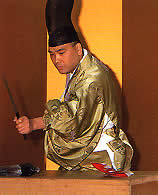‘Tadasu-no-mori Forest’ where the Takanogawa and Kamogawa
Rivers converge is said to derive its name from tadasu,
meaning ‘sandbank.’
Later, the Chinese character meaning ‘justifying falsehood’
was applied to this noun.
The area exudes a serene and peaceful atmosphere. During
the Edo Period (1603-1868), it was a popular spot for people
to enjoy the cool breeze in summer, and it still retains
the quiet and elegant atmosphere special to the precincts
of one of the oldest Shinto shrines in Kyoto, ‘Shimogamo
Shrine’designated as a ‘World Cultural Heritage’ by UNESCO.
This is a forest where the gods dwell, and the tranquil
and sacred air wafts through the entire area.

In this serene setting, KICHISEN, an authentic Kyoto-style
kaiseki restaurant, has been continuing its endeavor to
pursue the true spirit of kaiseki, the essence of Japanese
cuisine.

| 
|

Acquiring a deep appreciation of cooking at the age
of nine, Yoshimi Tanigawa was convinced that cooking
was his mission in life. Later, he came to Kyoto and
studied traditional Japanese cultural arts such as
‘tea ceremony,’ ‘flower arrangement,’ ‘incense ceremony,’
‘calligraphy,’ ‘Japanese poetry,’ etc., in order to
polish his sensitivity and acquire inspiration for
his profession.
Besides mastering the traditional court-style cuisine
(yusoku-ryori; cuisine prepared according
to the rules and traditions of the ancient court)
and its methods of using cutlery (ikama-ryu),
he has continued to explore new fields of cuisine,
such as a special curative diet catered to those suffering
from diabetes. He is making every effort to promote
the essence of real Kyoto-style cuisine, especially
to people abroad. Furthermore, by always remembering
the spirit of ‘discovering new things by studying
the past,’ he is doing his best endeavors to cultivate
his own style of cooking.
He took part in the popular TV program ‘Ryori-no-tetsujin
(the battle of the master chefs)’ broadcasted in July
1999, and defeated Masaharu Morimoto, another master
chef in Japanese cuisine. The theme of the contest
was ‘conger eel’, and his dexterity in preparing the
dish won the admiration of all the judges.
|
Introduced in the New York Times in the past, his restaurant has been visited
by many guests from abroad. Here’s a quotation from the New York Times.
Daniel Goleman, Tea Ritual (The New York Times, October
5, 1986)
…While there are many restaurants that can claim to serve
kaiseki, the purest form requires reservations in advance
for a meal that can take hours and can cost several hundred
dollars a person. For those on a more modest budget, KICHISEN,
a new kaiseki restaurant in Kyoto, offers full
meals from about *1$30 to $50 for lunch $50 to $78 for dinner,
KICHISEN (Phone: 075-711-6121) is on the Shimogamo-hon-dori
(street), opposite and just south of the Kyoto Prince Hotel.*2
Reservations are needed, and be sure to arrive promptly;
kaiseki dishes are cooked and served in a carefully
timed order.
Copyright ©1986 by The New York Times Co.
Reprinted by permission.
*1 These prices in the article are outdated. Please refer
to the website for the current prices.
*2 The Kyoto Prince Hotel no longer exists. Please refer
to the map at the end of the website.
 |
2 / 5 |
 |
